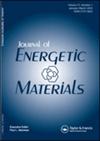HMX在加工过程中的结构演变
IF 1.9
3区 材料科学
Q3 CHEMISTRY, APPLIED
引用次数: 0
摘要
摘要利用x射线衍射和Rietveld分析研究了化学合成条件、铣削、涂层和压制等加工操作对HMX晶体结构的影响。在两种不同的装置和不同的洗涤方法合成后,首次观察到颗粒形态和x射线模式的强烈差异。在已知结构的基础上,假设优先取向,初步进行了衍射图样的改进。即使考虑到几个平面的取向,也不可能达到令人满意的一致,这可能归因于多态性或水合物的存在。可能的新多晶或水合物是亚稳态的,因为铣削导致了稳定的ß-HMX多晶。在涂层过程中没有发生这种转变,但观察到结构缺陷的增加。最后,挤压步骤没有引起任何转变,但令人惊讶的是导致了结构缺陷的减少,这可能是由于晶体细胞的各向同性变形和相关热处理的修复作用。关键词:晶体学;高能材料;shmx加工操作;x射线衍射致谢作者要感谢jean - franois Willart博士的有益讨论。披露声明作者未报告潜在的利益冲突。补充材料本文的补充数据可在https://doi.org/10.1080/07370652.2023.2267558上在线获取本文章由计算机程序翻译,如有差异,请以英文原文为准。
Structural evolution of HMX during processing operations
ABSTRACTThe impact of processing operations such as chemical synthesis conditions, milling, coating and pressing operations on the crystallographic structure of HMX has been studied using X-ray diffraction and Rietveld analysis. Strong differences in grain morphology and X-ray patterns were first observed after synthesis on two different setups with different washing methods. Diffraction pattern refinements were tentatively performed on the basis of known structures and assuming preferential orientations. The impossibility of achieving satisfactory agreement, even considering the orientation of several planes, could be attributed to the presence of polymorphism or hydrates. The possible new polymorphs or hydrates were metastable since milling led to the stable ß-HMX polymorph. No such transformation occurred during the coating operation, but an increase in structural defects was observed. Finally, the pressing step did not induce any transformation but surprisingly led to a decrease in structural defects, probably due to isotropic deformation of the crystallographic cell and the repairing effect of the associated thermal treatment.Keywords: Crystallographyenergetic materialsHMXProcessing operationsX-Ray diffraction AcknowledgmentsThe authors wish to thank Dr Jean-François Willart for useful discussions.Disclosure statementNo potential conflict of interest was reported by the author(s).Supplementary materialSupplemental data for this article can be accessed online at https://doi.org/10.1080/07370652.2023.2267558
求助全文
通过发布文献求助,成功后即可免费获取论文全文。
去求助
来源期刊

Journal of Energetic Materials
工程技术-材料科学:综合
CiteScore
5.70
自引率
4.80%
发文量
34
审稿时长
1.8 months
期刊介绍:
The Journal of Energetic Materials fills the need for an international forum of scientific and technical interchange in the disciplines of explosives, propellants, and pyrotechnics. It is a refereed publication which is published quarterly. Molecular orbital calculations, synthetic and analytical chemistry, formulation, ignition and detonation properties, thermal decomposition, hazards testing, biotechnology, and toxicological and environmental aspects of energetic materials production are appropriate subjects for articles submitted to the Journal.
 求助内容:
求助内容: 应助结果提醒方式:
应助结果提醒方式:


